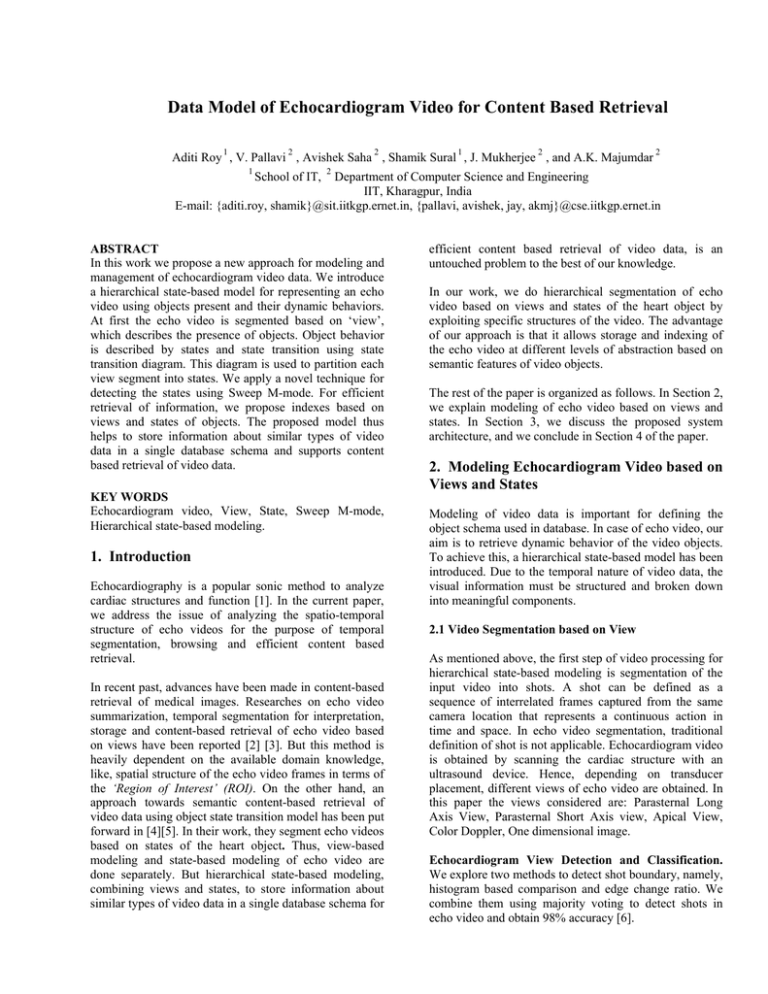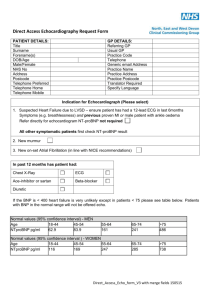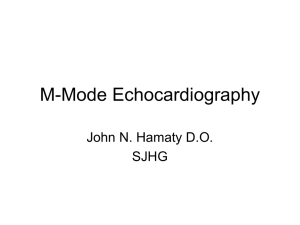Data Model of Echocardiogram Video for Content Based Retrieval
advertisement

Data Model of Echocardiogram Video for Content Based Retrieval
1
2
2
1
2
Aditi Roy , V. Pallavi , Avishek Saha , Shamik Sural , J. Mukherjee , and A.K. Majumdar
1
School of IT,
2
2
Department of Computer Science and Engineering
IIT, Kharagpur, India
E-mail: {aditi.roy, shamik}@sit.iitkgp.ernet.in, {pallavi, avishek, jay, akmj}@cse.iitkgp.ernet.in
ABSTRACT
In this work we propose a new approach for modeling and
management of echocardiogram video data. We introduce
a hierarchical state-based model for representing an echo
video using objects present and their dynamic behaviors.
At first the echo video is segmented based on ‘view’,
which describes the presence of objects. Object behavior
is described by states and state transition using state
transition diagram. This diagram is used to partition each
view segment into states. We apply a novel technique for
detecting the states using Sweep M-mode. For efficient
retrieval of information, we propose indexes based on
views and states of objects. The proposed model thus
helps to store information about similar types of video
data in a single database schema and supports content
based retrieval of video data.
KEY WORDS
Echocardiogram video, View, State, Sweep M-mode,
Hierarchical state-based modeling.
1. Introduction
Echocardiography is a popular sonic method to analyze
cardiac structures and function [1]. In the current paper,
we address the issue of analyzing the spatio-temporal
structure of echo videos for the purpose of temporal
segmentation, browsing and efficient content based
retrieval.
In recent past, advances have been made in content-based
retrieval of medical images. Researches on echo video
summarization, temporal segmentation for interpretation,
storage and content-based retrieval of echo video based
on views have been reported [2] [3]. But this method is
heavily dependent on the available domain knowledge,
like, spatial structure of the echo video frames in terms of
the ‘Region of Interest’ (ROI). On the other hand, an
approach towards semantic content-based retrieval of
video data using object state transition model has been put
forward in [4][5]. In their work, they segment echo videos
based on states of the heart object. Thus, view-based
modeling and state-based modeling of echo video are
done separately. But hierarchical state-based modeling,
combining views and states, to store information about
similar types of video data in a single database schema for
efficient content based retrieval of video data, is an
untouched problem to the best of our knowledge.
In our work, we do hierarchical segmentation of echo
video based on views and states of the heart object by
exploiting specific structures of the video. The advantage
of our approach is that it allows storage and indexing of
the echo video at different levels of abstraction based on
semantic features of video objects.
The rest of the paper is organized as follows. In Section 2,
we explain modeling of echo video based on views and
states. In Section 3, we discuss the proposed system
architecture, and we conclude in Section 4 of the paper.
2. Modeling Echocardiogram Video based on
Views and States
Modeling of video data is important for defining the
object schema used in database. In case of echo video, our
aim is to retrieve dynamic behavior of the video objects.
To achieve this, a hierarchical state-based model has been
introduced. Due to the temporal nature of video data, the
visual information must be structured and broken down
into meaningful components.
2.1 Video Segmentation based on View
As mentioned above, the first step of video processing for
hierarchical state-based modeling is segmentation of the
input video into shots. A shot can be defined as a
sequence of interrelated frames captured from the same
camera location that represents a continuous action in
time and space. In echo video segmentation, traditional
definition of shot is not applicable. Echocardiogram video
is obtained by scanning the cardiac structure with an
ultrasound device. Hence, depending on transducer
placement, different views of echo video are obtained. In
this paper the views considered are: Parasternal Long
Axis View, Parasternal Short Axis view, Apical View,
Color Doppler, One dimensional image.
Echocardiogram View Detection and Classification.
We explore two methods to detect shot boundary, namely,
histogram based comparison and edge change ratio. We
combine them using majority voting to detect shots in
echo video and obtain 98% accuracy [6].
After detecting views, we classify the views by
considering signal properties of different views. We use
the fact that, for each view, different sets of cardiac
chambers are visible. The number of chambers present,
their orientation and the presence of heart muscles in each
view, gives different patterns of histogram. We identify
the views based on their unique histogram patterns. We
train a neural network for classifying the views using their
histogram of each frame. An overall precision of 95.34%
[6] is obtained.
2.2 State-based Video Representation
State transition diagram describes all the states that an
object can have, the events or conditions under which an
object changes state (transitions) and the activities
undertaken during the life of an object (actions). In an
echo video, the two states are systole and diastole.
Figure 1 shows the state transition diagram of heart. Heart
belongs in two states, namely, systole and diastole. When
ventricles start expanding, transition occurs from systole
state to diastole state. Similarly, transition occurs from
diastole to systole with ventricle contraction.
Fig. 1. State transition diagram of heart
Identification of States using Sweep M-mode. For Mmode echocardiography, the signal is obtained from the
time sequence of a one-dimensional signal locating
anatomic structures from their echoes along a fixed axis
of emission. We use a multiple M-mode generation
method termed as ‘Sweep M-mode’. It is so named
because scanning the intensity along a straight line, while
the straight line is continuously swept by a specified
interval in a direction normal to a fixed axis generates
multiple M-modes. For obtaining sweep M-mode, user
draws a line perpendicular to the direction of left
ventricular wall motion (see vertical line in Figure 2).
Scanning the intensity value along the straight line
perpendicular to this vertical line creates sweep M-modes,
taking it as Y-axis, for each frame of the video considered
as X-axis. The Sweep M-modes are generated along the
horizontal broken straight lines as shown in Figure 2. One
such M-mode is shown in Figure 3(a).
Border Extraction. Before border extraction, we remove
noise and enhance the image by edge detection in Mmodes using Gaussian filtering and Sobel operator
respectively. Then, we extract the border by searching for
optimal path along time axis. We use a maximum
intensity tracking procedure [6] whose performance is
improved by using a local window to predict the position
of the next border point. Since border tracking of all the
M-modes is not perfect due to inherent noise,
discontinuities and absence of well-defined edges, we
need to select only those few that are meaningful. It has
been observed that in M-modes where tracking is perfect,
the distance between the two cardiac borders never
exceeds a threshold value. But if the distance value
exceeds the threshold, the M-modes are identified as mistracked. We use this as a heuristic to select the proper Mmodes. One such tracked M-mode corresponding to
Figure 3(a) is shown in Figure 3(b).
State Identification. For extracting the state information
from each M-mode, we first compute the distance
between the two endocardium borders in each frame, as
shown in Figure 3(b). Figure 3(c) shows the variation of
cardiac border distance with respect to time.
We use the distance information to classify the echo video
frames into two classes, namely, systole and diastole. The
troughs of Figure 3(c) indicate end systole points and the
peaks indicate the end diastole points. During diastole, as
the left ventricle expands, the cardiac border distance
increases. Thus in echo video, the frames corresponding
to positive slope in distance graph are classified as
diastolic state frames. Similarly, left ventricle contracts in
systole state. So, frames corresponding to negative slope
are classified as systolic. Thus the process of state
detection from an echo video is completed. The state
transition graph obtained from Figure 3(c) is shown in
Figure 3(d). It has been observed that the individual plots
for the selected M-modes have many false state
transitions. So we combine them using majority voting to
identify the state information of each frame. The
misclassification error is about 12.36%.
Fig. 2. User drawn straight line and cavity on a chosen
frame of video
(a)
(b)
(c)
(d)
Fig. 3. (a) M-mode image (b) Border extracted M-mode
image, (c) Variation cardiac border distance with time, (d)
State transition graph
3. System Architecture and Implementation
EchoView = (VideoID, EchoViewID, StartFrame, EndFrame,
ViewType)
We have developed a prototype system, which uses the
temporal segmentation techniques presented in the
previous section for hierarchical state-based indexing of
echo video.
EchoState = (VideoID, EchoViewID, StateID, StartFrame,
EndFrame, StateType)
3.1 General Architecture of the proposed System
The proposed system has an architecture that can be
subdivided into two functional units - the first one is for
database population and the second for database querying.
The system architecture is summarized in Figure 4. First,
the echo videos are split into short segments called views
by the view detector. The view detector basically
segments the videos based on the different views as
mentioned in Section 2.1. After that, view classifier
classifies each view. Then for each shot, the state
extractor identifies the states. Shot and state information
is stored in a database hierarchically. When a query is put
to the system, the query processor module interprets it and
retrieves the video segments based on its semantic
content. This technique leads to a simple and fast retrieval
of the desired video segment.
EchoSubState = (VideoID, EchoViewID, StateID, SubStateID,
StartFrame, EndFrame, SubStateType)
EchoVideo relation maintains information about a
video and the corresponding patient. For each new video a
unique VideoID is generated. The EchoView records
information about all views identified in each video. The
EchoState contains information about every state
identified in each view segment in a video. Similarly,
EchoSubState maintains information of the sub states for
each state. Appropriate database tables are created using
this schema and populated. The corresponding ER
diagram of the echo database is shown in Figure 5.
3.3 Database Population
In the current implementation, this step is performed
semi automatically. User can segment video for either
view indexing or state based indexing and populate the
database through a graphical interface. After performing
shot detection, shot classification is done for automatic
annotation of shots. User has option to annotate the views
manually if the shots are misclassified and also to
redefine the view boundaries. Once segmentation based
on views is completed, state detection operation is
performed for state information extraction for specified
view. This part is fully automated. After temporal
segmentation, database tables are updated accordingly. In
order to retrieve video segments corresponding to a
certain view and state efficiently and quickly, hierarchical
state-based indexing scheme is used.
3.4 Database Querying
Fig. 4. Architecture of the proposed system
3.2 Schema Specification
In order to retrieve video segments depicting certain
views and states and state transitions of objects, view
based indexing and state based indexing scheme is
adopted. Our video database has the following important
schema.
EchoVideo = (VideoName, VideoID, Duration, Location,
DateOfRecording, PatientName,Age,Sex)
A user-friendly interface is provided for ease of
specifying a query. For retrieval of the video segments
describing state in specified view, user has to select the
state name and view type accordingly. Subsequently
corresponding SQL queries are composed. It uses the
EchoState table, where state based indexing is used, to
identify the location of a state in a specified view.
Query on Views: Here, we demonstrate through following
example how view based information retrieval can be
achieved in the proposed video database management
system. Figure 6(a) shows the result of the query to
retrieve all the video segments corresponding to Long
Axis View from echocardiogram database of a particular
patient. In the query interface shown in Figure 6(a), the
retrieved segments are listed in the bottom part of the left
panel. User can play the video segments by selecting them
one by one. It may be noted that the retrieved segments
are shown with their segment number and the
corresponding start and end frame numbers of the
segment with respect to the original video.
Query on States: Since, the main idea of the proposed
approach of video modeling is to extract state information
of objects depicted in a video, content of a video is
described by states of the heart and their transitions. In
case of echocardiogram images, such state information
describes the functionality of heart. Hence, we
demonstrate through following examples how state based
information can be retrieved. Figure 6(b) shows the result
of the query to retrieve video segments where heart is in
systole state. The results of the query appear as video
segments with their start frame and end frame numbers
along with the video identifier as before.
Now, we demonstrate how the hierarchical view-state
relationship works. The following query is used to
retrieve segments in which the heart is in diastolic state in
Short Axis View. Figure 6(c) shows the query interface as
it appears after the query has been generated and
executed.
4. Conclusions
In this paper we have proposed a new approach for
hierarchical state-based modeling of echo video data by
identifying the views and states of objects. First, the state
detector detects the view boundaries using histogram
based comparison and edge change ratio. Next, the state
classifier classifies each view by considering signal
properties of different views. Then, the state extractor
extracts state information from each view segment using a
new type of M-mode generation method named as sweep
M-mode. We have used this approach of hierarchical
state-based modeling to develop an object relational video
database for storage and retrieval of echocardiogram
video segments. However, the finer (sub state)
segmentation of echocardiogram video is not done till
now. This is part of our future work.
Fig. 5. ER diagram for echo database
[3]S. Ebadollahi, S.F. Chang, & H. Wu, Automatic view
recognition in echocardiogram videos using parts-based
representation. Proc. IEEE Computer Society Conference
on Computer Vision and Pattern Recognition,
(CVPR’04), Vol. 2, June 2004, II- II-9.
[4]P.K. Singh, & A.K. Majumdar, Semantic contentbased retrieval in a video database. Proc. Int’l Workshop
on Multimedia Data Mining, (MDM/KDD’01), August
2001, 50-57.
(a)
[5]B. Acharya, J. Mukherjee, & A.K. Majumdar,
Modeling dynamic objects in databases: a logic based
approach. LNCS 2224, Springer Verlag, ER 2001, 449512.
[6]A. Roy, S. Sural, J. Mukherjee, & A.K. Majumdar,
Modeling of Echocardiogram Video Based on Views and
States. Indian Conference on Computer Vision, Graphics
and Image Processing, (ICVGIP’06). (To be published)
(b)
(c)
Fig. 6. Query result: (a) Long Axis View of heart (b)
Heart is in systolic state (c) Heart is in diastolic state and
in Short Axis View
Acknowledgement
We are grateful to Dr. S. Ramamurthy from AIIMS, New
Delhi for providing us the echocardiogram videos and the
information, which help us greatly in our work.
This work is partially supported by the Department of
Science and Technology (DST), India, under Research
Grant No. SR/S3/EECE/024/2003-SERC-Engg.
References
[1]H. Feigenbaum,
FEBIGER, 1997).
Echocardiography
(LEA
&
[2] S. Ebadollahi, S.F. Chang, & H. Wu, Echocardiogram
videos: summarization, temporal segmentation and
browsing. Proc. IEEE Int’l Conference on Image
Processing, (ICIP’02), Vol. 1, September 2002, 613-616.



